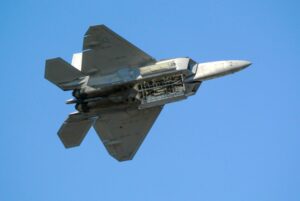Although references to deterrence are regularly trotted out to justify defence acquisition decisions and alliance policy, the place of the idea of deterrence in Australia’s strategic policy is opaque and poorly understood. That the effectiveness of a deterrence strategy is highly dependent on contingent circumstances is regularly left unaddressed by advocates of ever greater defence spending.

The second of Australia’s three key strategic objectives is to “deter actions against our interests”, although what this means in practise is largely unexamined. That hasn’t prevented apostles of greater defence spending from throwing the term around with Mosaic authority. However, the record shows deterrence doesn’t always succeed, despite the impression given by the government, and its chorus among the commentariat, that its just a matter of buying bigger and better submarines and missiles.
Deterrence is a layered concept with three main components; capability, credibility, and communication. That is, to deter an adversary from a particular action the minimum requirement is to have the military capability to force them to weigh the costs and benefits of achieving their objective in the face of the likely level of opposition. Without the clear intention to employ force to resist the adversary’s attempt to gain their objective there is no deterrence strategy. Then, crucially, the intention to resist the adversary must be convincingly communicated to the adversary. The weighting of each element can vary radically depending what’s at stake at the time.
With conventional deterrence, there are immediate and longer term considerations. Confronted with a situation, either tomorrow or decades hence, where an attack on Australia is imminent, or military action against some Australian strategic interest in the region is in preparation, the success of a deterrence strategy will depend heavily on the adversary’s perception of the relative capabilities at hand in the moment. A longer term deterrence strategy confronts the difficultly of predicting where, when, against who, and over what issue the deterrence strategy will be employed. Apart from the sheer impossibility of knowing decades in advance what the objective of friction might be, anticipating advances in military technology and shifts in geopolitics is fraught with uncertainty.
Another feature of deterrence strategy is that it involves two sides. If an adversary believes that at a point in time they have the superiority of forces required to achieve their objective they could be tempted to act pre-emptively before the other side can prepare; thus an anticipation of deterrence could precipitate a surprise attack. In any event, it is always impossible to be sure it was deterrence, the prospect of strong resistance, that deterred an assault.
The psychological aspect of deterrence is also relevant. Simply adding up the forces on either side of a dispute will not reveal the strength or depth of the motivation an adversary might have with regard to a certain objective, or what might be the domestic political pressures to which they are subject. Adversary commanders might be overconfident of their ability to succeed, or not have accurate or complete intelligence of the relative strengths. In the end an adversary might be prepared to suffer losses, absorb harms, or take risks that the deterrer finds hard to believe.
A final perplexing aspect for the deterrer relates to how interests are defined. Is any threat to anything that might affect Australia in anyway something that Australia should signal its determination to gamble on deterrence as a strategy? That would be irrational. However, drawing the line is a difficult strategic calculation. In any potential conflict, the adversary will make a judgement on how strongly motivated Australia is to defend a particular interest, and what retaliatory consequences it’s prepared to tolerate. Will Australia be prepared to carry out its threat?
Deterrence is a key factor in Australia’s declared defence policy. The Defence Minister has declared that the expensive Attack class submarines are justified because “an undetected submarine to project force far forward is the basis of our nation’s strategic deterrent”. A submarine “will influence [an adversary’s] calculus of the cost of threatening Australia’s interests”. A judgement endorsed in ASPI’s paper Submarines: your questions answered, which is replete with references to the deterrence powers of submarines.
The Minister also justified Australia’s interest in the test and evaluation of hypersonic weapons in order to give “the ADF more options to deter aggression against Australia’s interests”. Hypersonic missiles are “capabilities that deter actions against Australia”. Sympathetic commentators have agreed, stating hypersonic missiles add “more deterrence weight to our defence force”.
So what does the government envisage the submarines, new naval vessels, F-35s, and variety of long range missiles will deter. In the case of a direct threat of major attack on Australia by China, the only regional power capable of such an assault, only the direct counter-threat of US intervention could have any deterrent value. China would need to have a vital national or strategic interest at risk to mount such an attack. In the absence of the US, China’s overwhelming military capability in combination with a strong motivation, would render any pretence of a deterrence capability by Australia farcical.
Even more unsound it the idea that an Australian government would, independently, threaten Chinese assets somewhere in the region when there was no direct threat to Australian territory and citizens. It is hard to conceive of a situation where Australia alone would attempt to threaten China in order to deter it from some act by sinking one of its vessels, or destroying land based assets, via a submarine or long range missile attack.
The constant rhetorical resort to deterrence as the justification for acquiring expensive high-tech weapons platforms and systems is simply deceptive. Given the opportunity cost, for education, health, and research, of bloated defence investment, the Australia public deserves a far more fulsome explanation of what the government’s throwaway references to deterrence mean.
Mike Scrafton was a Deputy Secretary in the Victorian Department of Sustainability and Environment, senior Defence executive, CEO of a state statutory body, and chief of staff and ministerial adviser to the minister for defence.

Comments
7 responses to “The deceit of deterrence; a bankrupt strategic justification for defence expenditure”
Is this really a “deceit” imposed on the Australian public by its Government?
Can someone take just one of the three strategic priorities set out on the 2020 Defence Strategic Update & 2020 Force Structure Plan, dissect it in terms of its apparent ‘failings’, and reach conclusions about overall defence policy?
The three designated priorities are to: shape Australia’s strategic environment; deter actions against Australia’s interests; and respond with credible military force, when required.
It is, of course, the last which dictates the equipment allocation, force structure and readiness posture of the ADF …. this being a consequence of contingency plans which have been developed in response to the identified ‘threat’.
Seems to me that before we can criticise the components of a ‘credible military force’, we have to analyse the threat and its consequent force structure.
Deterrence is a deception of the military oligarchs, plutarchs and their paid think tanks to dupe the tax paying public into subsidising the armament and ordinance corporations that employ the oligarchs and plutarchs who subsequently become military oligarchs. ASPI, Ernest Young, Thales, ADF and the submarine programme are a classic case in point. Also it reflects their hatred of socialism and outright refusal to deploy diplomacy for lasting peace with socialist nations or those nations (Iran and Syria for instance) that speak out against Zionist Israel’s oppression of Palestine.
Thanks Mike for another lucid analysis/deconstruction of our poorly thought out defence policy.
A couple of things strike me when reading your article.
The first is that if a conflict was to break out between the US and China, our working assumption should be that the US is not facing just China, but China and Russia together. Whilst there is (deliberate) strategic ambiguity in their comprehensive strategic partnership, it seems clear that both these countries have realised that they will only survive against the Western world united. The flow on implication for Australia is that the US, similar to the British in 1942, will be stretched on multiple fronts and this must be considered in any calculations of what support we would receive from the US. Perhaps not getting involved in a China-Russia – US conflict in the first place would be the wisest move.
The second is the lack of asymmetry in our defence thinking when trying to achieve deterrence. The Iranian’s seem to have this down pat. They’re precision missile systems (now proven in the attacks on Saudi oil infrastructure and US bases in Iraq) can effectively hit anywhere in the Middle East (including Israel and large numbers of US bases) that provide a very effective deterrent. Australia’s circumstances are very different. A few submarines or hypersonic missiles are unlikely to change the calculus of a potential aggressor when they have many options available other than military conflict. Fortunately for Australia, unlike Iran, we have no credible threat challenging us, which raises the question of what are we trying to deter?
The final comment is that the rate that military technology is increasing relative to defence capability acquisition cycles means that Australia simply cannot afford to counter every piece of new technology. For example, as Andrei Martyanov points out in his book The Real Revolution in Military Affairs, hypersonic missiles (which Russia now has multiple variants in service) mean that the major force projection capability of the United States Navy (Carrier Battle Groups) is now as obsolete as the battleship in World War II. Another example is the use of low-cost drones to destroy large numbers of armoured vehicles in the Nagorno-Karabakh conflict. These examples suggest that major components of our defence force are extremely vulnerable in any major conflict. How much are we willing to spend to counter these weapon systems, when we face no actual credible threat other than those created by our alliance with the United States?
Deterrence in itself seems a perfectly fine idea. As I understand it, Switzerland and Singapore rely on deterrence to keep their countries safe.
The issue seems to be that “deterrence” as used by some defence analysts to mean a capability to project power outside national boundaries. Whereas strictly speaking, “deterrence” is about making an attack (by an outside power) very costly.
I suspect there is some Orwellian motive to make offensive aggression seem legitimate and defensive.
Just my take!
The weapons salesmen don’t take these strategic arguments seriously. Their job is to frighten the public into parting with as much money as possible. The word “deterrence” sells well to both hawks and doves.
Mike, Thanks for a succinct and especially timely examination of the invocations by governments to use the term. It surprises me that so little critical understanding of the term and the way it’s wave around makes it into the national defence debates. It seems to be the result of studied ignorance. And perhaps to deterrence we might add ‘security’ – a term which seems to escaped definition in the same debates.
Has anyone done calculations on how the money could be better spent? Funding hospitals in China?